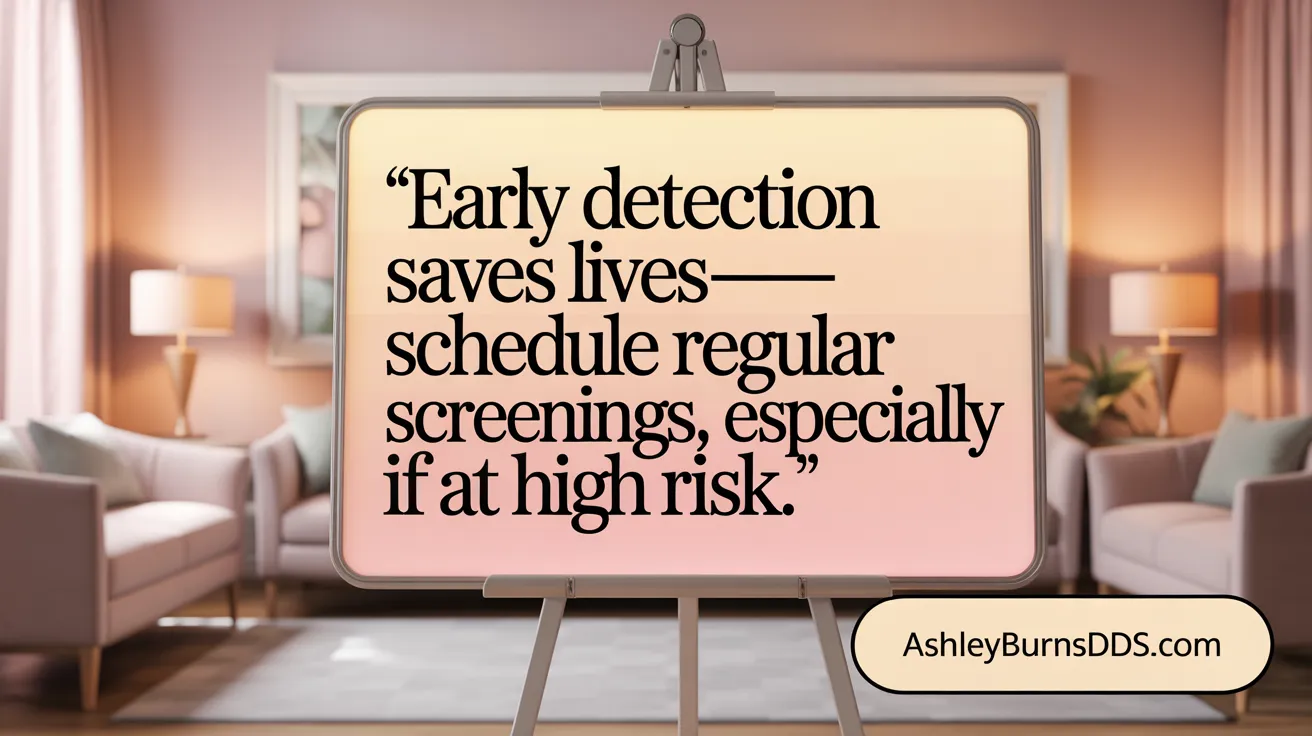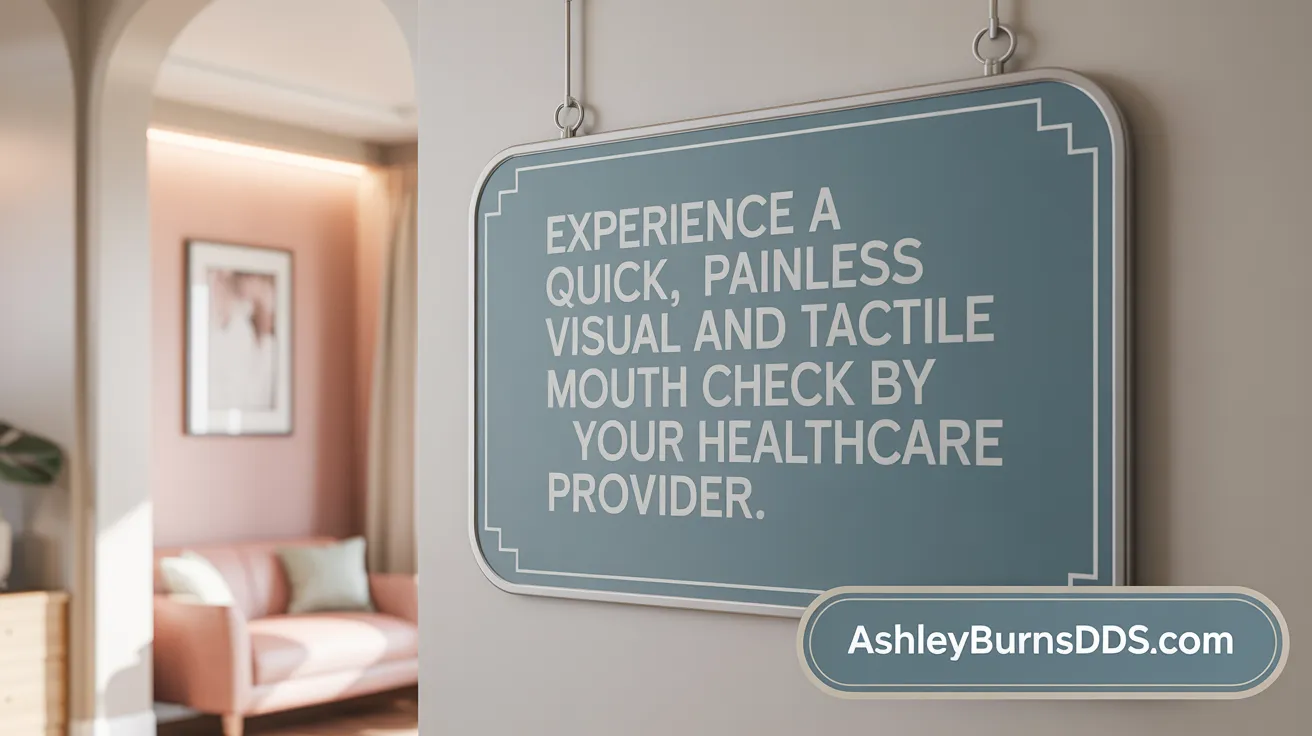Understanding Oral Cancer Screening
Oral cancer screenings are crucial preventive health measures designed to detect early signs of cancer in the mouth and surrounding areas. This quick, non-invasive procedure is often part of routine dental or medical checkups, serving as a vital tool to catch potential issues before they develop into more serious conditions. Given the significant impact early detection has on treatment success and survival rates, understanding what happens during a routine oral cancer screening can empower patients to take proactive steps for their oral health.
The Purpose and Importance of Oral Cancer Screening

What is the purpose and importance of oral cancer screening?
The primary goal of oral cancer screening is to detect mouth and throat cancers at an early stage, before symptoms appear or the disease progresses to advanced phases. This early detection is crucial because it significantly improves the chances of successful treatment and survival. Routine visual and tactile examinations conducted by dentists or healthcare providers can identify suspicious lesions like leukoplakia or erythroplakia, which may develop into malignancies. These screenings help catch precancerous conditions early, allowing for timely intervention. While screening does not guarantee prevention, it plays a vital role in reducing morbidity and enhancing the overall prognosis.
Why is early detection of oral cancer significant?
Identifying oral cancer early is essential because treatment outcomes are much more favorable when the disease is localized. Early diagnosis can lead to less invasive therapies, preserve oral function, and reduce complications. Studies show that the five-year survival rate can reach up to 85% if the cancer is found at an initial stage. Regular examinations, especially for individuals at high risk such as tobacco or heavy alcohol users, HPV-infected persons, and those with prior cancer history, are vital.
Advances in technology, including telehealth, AI diagnostic tools, and adjunctive screening methods like fluorescence lights or saliva tests, are promising in the early detection landscape. Despite some organizations questioning the efficacy of population-wide screening, targeted efforts in high-risk groups can have a positive impact. Ultimately, proactive screening efforts are integral in saving lives, preventing severe treatments, and maintaining quality of life for patients.
Step-by-Step Procedures During an Oral Cancer Screening
An oral cancer screening is a quick and systematic process performed by healthcare professionals during routine dental oral exams. Understanding what to expect during oral cancer screening can help patients feel more prepared and informed.
Initially, the provider reviews the patient's medical history and discusses any symptoms or risk factors such as tobacco or alcohol use. This step sets the context for the examination.
The visual examination is the core of the screening. The professional carefully inspects the entire inside of the mouth, including the cheeks, gums, lips, tongue, palate, and the floor of the mouth. They look for signs of abnormalities like lumps, sores, red or white patches, or discolorations that do not heal.
Palpation techniques are employed next. The healthcare provider gently feels the tissues inside the mouth and around the face and neck for unusual lumps, bumps, or thickened areas. They also examine the neck and throat for swollen or tender lymph nodes, which could indicate infection or malignancy.
To enhance detection, specialized tools may be used. For example, dyes like toluidine blue can stain suspicious lesions, making abnormal tissues stand out. Fluorescent lights or mouth rinses with fluorescent solution, such as VELscope or fluorescent mouthwash, can help identify areas of abnormal tissue by making healthy tissues appear darker and suspicious areas white.
If any abnormalities are detected during visual or tactile examinations, follow-up procedures are recommended. These often include performing a biopsy—where a small tissue sample is removed and sent to a lab for analysis—or other diagnostic tests like brush biopsies or cytology.
Overall, these procedures aim to catch early signs of oral cancer or precancerous conditions. Early detection greatly improves treatment options and survival rates, making regular screenings an essential part of oral health care.
What to Expect During Your Routine Oral Cancer Exam
 During a routine oral cancer examination, a healthcare provider performs a quick and painless visual and tactile inspection of the mouth, lips, face, and neck to look for abnormalities such as red or white patches, sores, lumps, or swelling. They examine areas including the cheeks, gums, tongue, roof and floor of the mouth, and tonsils, feeling for any lumps or hard spots, and may use special lights or dyes to highlight suspicious tissues. The provider will also check the neck and throat for enlarged lymph nodes or other signs of concern. They may ask about symptoms like persistent sore throat, difficulty swallowing, or lumps in the neck, and discuss risk factors such as tobacco or alcohol use. If any abnormal findings are noted, further tests like biopsies are recommended to confirm diagnosis, but the overall process is typically brief, non-invasive, and essential for early detection of oral cancers.
During a routine oral cancer examination, a healthcare provider performs a quick and painless visual and tactile inspection of the mouth, lips, face, and neck to look for abnormalities such as red or white patches, sores, lumps, or swelling. They examine areas including the cheeks, gums, tongue, roof and floor of the mouth, and tonsils, feeling for any lumps or hard spots, and may use special lights or dyes to highlight suspicious tissues. The provider will also check the neck and throat for enlarged lymph nodes or other signs of concern. They may ask about symptoms like persistent sore throat, difficulty swallowing, or lumps in the neck, and discuss risk factors such as tobacco or alcohol use. If any abnormal findings are noted, further tests like biopsies are recommended to confirm diagnosis, but the overall process is typically brief, non-invasive, and essential for early detection of oral cancers.
Signs and Symptoms Assessed During Screening
 During an oral cancer screening, healthcare providers carefully examine the mouth and associated areas for various signs that could indicate the presence of malignancy or precancerous conditions. Visual inspection focuses on identifying lesions such as leukoplakia—white patches—and erythroplakia—red patches, which are often considered warning signs. The examiner also looks for non-healing sores or ulcers that persist beyond two weeks, as well as lumps, bumps, or areas of tissue thickening that may be felt with gentle palpation.
During an oral cancer screening, healthcare providers carefully examine the mouth and associated areas for various signs that could indicate the presence of malignancy or precancerous conditions. Visual inspection focuses on identifying lesions such as leukoplakia—white patches—and erythroplakia—red patches, which are often considered warning signs. The examiner also looks for non-healing sores or ulcers that persist beyond two weeks, as well as lumps, bumps, or areas of tissue thickening that may be felt with gentle palpation.
Changes in the color and texture of the oral mucosa are closely evaluated. This includes noticing any irregularities, rough patches, or areas that differ in appearance from surrounding tissue. The presence of unusual patches, whether white, red, or mixed, can be significant indicators warranting further investigation.
Additionally, symptoms such as persistent pain in the mouth, difficulty swallowing (dysphagia), speaking, or opening the mouth, as well as numbness or loss of sensation in the lips, tongue, or jaw, are assessed. Swelling in the neck or jaw region, often due to enlarged lymph nodes, is also detected, as it may suggest regional spread or primary tumor presence.
This comprehensive assessment aims to detect any abnormal growths, changes, or symptoms early, thereby facilitating timely diagnosis and intervention. Quick identification of these signs can lead to further diagnostic procedures like biopsies, significantly improving the chances of successful treatment and better patient outcomes.
Techniques and Tools Used in Oral Cancer Screening

Visual and tactile inspection
The cornerstone of oral cancer screening involves a thorough visual examination for oral cancer of the inside of the mouth using adequate lighting and mirrors. Healthcare professionals inspect areas such as the lips, cheeks, gums, tongue, roof and floor of the mouth, and the back of the throat for abnormalities. Palpation, or feeling tissues with gloved fingers, helps detect lumps, thickening, or indurations that are not visible externally. This process is swift, typically lasting less than five minutes, and aims to identify suspicious lesions such as leukoplakia (white patches), erythroplakia (red patches), ulcers that do not heal, or asymmetrical tissue growths.
Use of adjunctive screening tools such as toluidine blue dye and special fluorescence lights
While visual and tactile examinations are standard, adjunctive tools can enhance detection of abnormal tissues. Toluidine blue dye is frequently used to stain suspicious areas, as cancerous or precancerous tissues tend to absorb the dye more readily. Additionally, special lights that cause tissues to fluoresce, such as VELscope, can help highlight abnormal tissue that may appear normal to the naked eye. Fluorescent mouthwash or autofluorescence devices can distinguish between healthy and potentially malignant tissues based on their response to specific wavelengths. However, these tools are adjuncts rather than replacements for the fundamental visual and tactile exam.
Brush biopsies and cytology for suspicious lesions
When lesions appear suspicious during the initial examination, further investigation is warranted. Brush biopsy is a minimally invasive technique where cells are scraped from the surface of the lesion using a small brush. These cells are then analyzed microscopically for atypia or malignant features. Cytology, the microscopic examination of collected cells, can help determine if a biopsy is needed. If cytology results are inconclusive or highly suspicious, a surgical biopsy—removing tissue for detailed laboratory analysis—is performed to confirm the diagnosis.
Limitations and recommendations on adjunctive techniques
Despite their usefulness, adjunctive tools like dyes and fluorescence are not definitive diagnostic methods. They are prone to false-positive results, as benign conditions may also cause abnormal appearances. Accordingly, professional guidelines emphasize that these techniques should supplement, not replace, comprehensive visual and tactile examinations. The current recommendation is to use these tools judiciously, especially in high-risk or ambiguous cases, and always confirm suspicious findings with biopsy.
Role of clinical protocols and professional guidelines
Professional organizations, including the American Dental Association and the American Academy of Oral and Maxillofacial Pathology, endorse routine oral cancer screenings during dental checkups. Protocols recommend a systematic approach: a detailed history, risk factor assessment, visual inspection, palpation, and when necessary, adjunctive testing. The use of adjunctive tools may increase detection sensitivity but must be integrated within established clinical protocols to optimize patient care. Importantly, guidelines stipulate that any suspicious lesion warrants biopsy or specialist referral, given the limitations of screening tools and the critical importance of definitive diagnosis.
| Technique | Purpose | Limitations | Guidelines |
|---|---|---|---|
| Visual and tactile exam | Detect visible abnormalities and felt lumps | May miss early or hidden cancers | Core component, performed regularly |
| Toluidine blue dye | Highlight suspicious tissues | False positives in benign conditions | Use as adjunct, confirm with biopsy |
| Fluorescent lights | Identify abnormal tissue fluorescence | Not definitive, can misidentify benign tissue | Supportive tool, not routine |
| Brush biopsy | Sample cells for cytology | Not conclusive, false negatives possible | For suspicious lesions, follow with biopsy |
| Biopsy | Confirm diagnosis | Surgical procedure, patient discomfort | Gold standard, indicated for suspicious findings |
This comprehensive approach combining visual, tactile, and adjunctive methods enhances the effectiveness of oral cancer screening, aligning with current clinical recommendations to detect disease early while minimizing false alarms.
Frequency of Screening and Self-Examination Practices

When and how often should individuals undergo oral cancer screening?
Individuals should include regular oral cancer screenings as part of routine dental or medical examinations. For adults over the age of 40, an annual screening is generally recommended to ensure early detection.
For individuals aged 20 to 40 without specific risk factors, screenings can be scheduled every three years.
However, those with higher risk factors — such as tobacco use, heavy alcohol consumption, HPV infection, or a family history of cancer — are encouraged to request yearly screenings.
Routine examinations involve visual and tactile assessments of oral and oropharyngeal regions, sometimes using special dyes or lights to identify suspicious areas. These checks are usually performed during standard dental visits and require no special preparation.
Starting screening at age 18 can help catch early signs, especially in high-risk groups, improving treatment success and survival rates.
Early detection facilitated by regular screening significantly impacts outcomes, making adherence to recommended intervals vital.
What techniques can individuals use for self-examination and awareness of oral cancer signs?
Self-examination is an effective way to stay vigilant about potential signs of oral cancer. Starting at age 16, individuals are encouraged to check their mouth monthly.
Using a mirror and good lighting, examine the lips, cheeks, gums, tongue, roof of the mouth, and the floor of the mouth. Look for persistent sores, white or red patches, lumps, or areas of texture change that do not heal within two weeks.
Feel for any lumps, swelling, or thickened tissue in the neck and around the jaw, as these can be signs of underlying issues.
During the exam, remove dentures or any oral appliances to ensure a thorough check.
Signs to watch for include soreness or ulcers that won’t heal, red or white patches, unusual lumps, numbness, difficulty swallowing or speaking, and persistent pain.
Any abnormal findings should prompt consultation with a healthcare professional for further evaluation.
Routine self-assessment complements professional screenings and can lead to early diagnosis, dramatically improving outcomes in case of signs of malignancy.
Summary: Embracing Routine Oral Cancer Screenings for Better Health
Routine oral cancer screenings are brief yet critically important procedures that empower early detection of potentially life-threatening conditions. Through detailed visual and physical examination, often enhanced by specialized tools, healthcare providers can identify early warning signs and initiate timely interventions. Adhering to recommended screening schedules, particularly for those at higher risk, combined with monthly self-examinations, provides a proactive approach to oral health. Early diagnosis not only raises survival rates but also mitigates the need for aggressive treatments and complicated surgical procedures. Staying informed, attending regular checkups, and recognizing symptoms are essential steps in preventing the progression of oral cancer and maintaining overall well-being.
